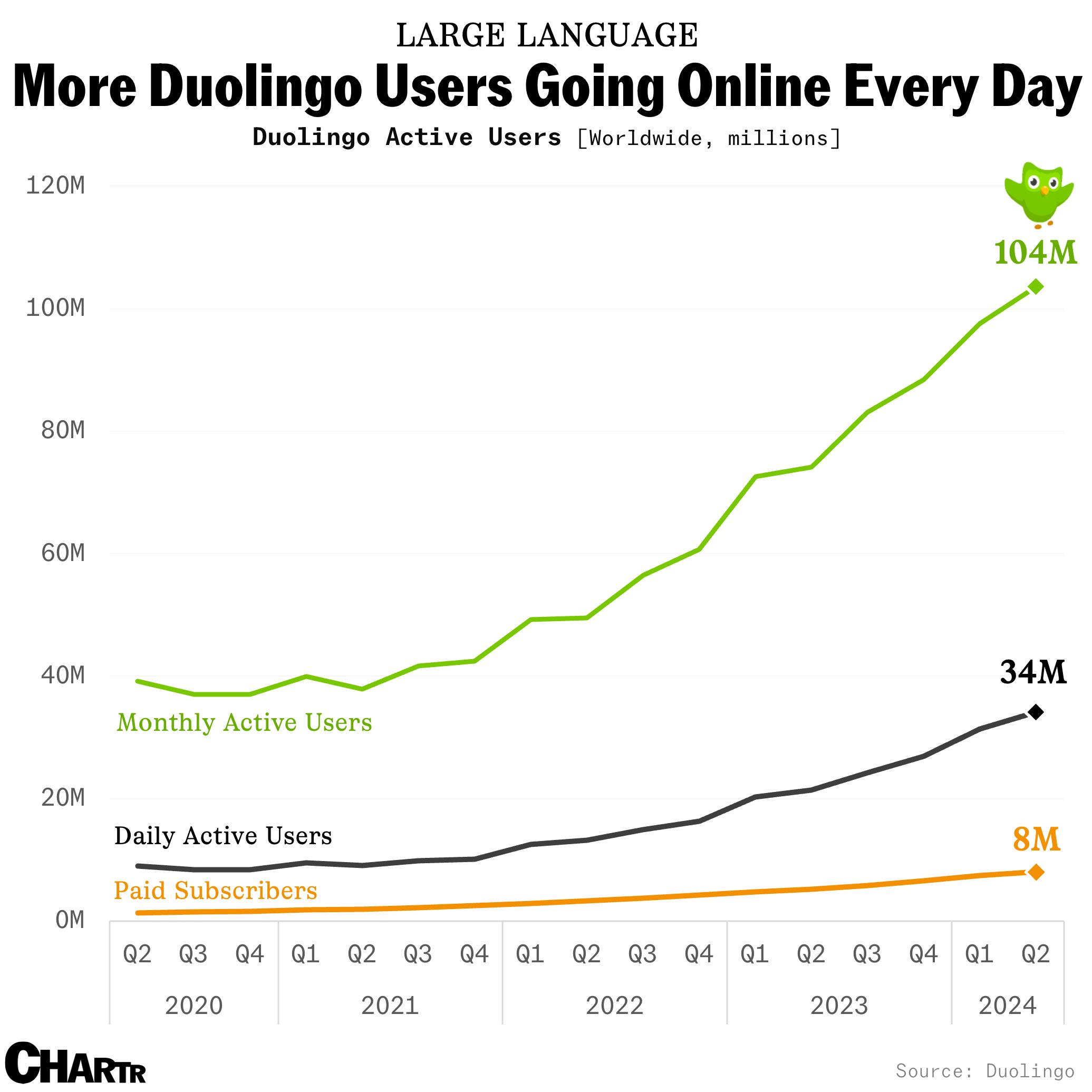Duolingo notifications: persistent, annoying, and oh-so-effective
The language-learning app now has more than 100 million monthly active users
Dua Lipa. Brazilian butt lifts. Clapping back in the comments.
Not a slam poem about the digital age, but rather some of the unconventional marketing strategies employed by the world’s leading mobile learning platform… by way of a green owl mascot with a penchant for intimidation.
Owl for one...
Duolingo — the app that encourages users to learn languages by completing short daily lessons — has exploded in popularity since its founding in 2011. In that time, it’s built a uniquely offbeat online presence, as well as a reputation for persistent notifications and overt gamification.
The company’s latest earnings, released Wednesday, reported its 5th consecutive profitable quarter, with total bookings of ~$190 million and net income of over $24 million, a more than 6x increase on the same period a year prior. It also saw Duolingo hit a significant milestone: 100 million monthly active users (MAUs).
Although the Q2 report sent Duolingo shares up more than 10% on the news, it’s been a bumpy year for the stock, which is still down 21% year-to-date. Analysts have pointed to a deceleration in growth for its vital daily active user count in the previous quarter as a reason why investors might be tentative to go all-in on lingo.
…and one for Owl
With users as its lifeblood, retaining aspiring polyglots, and eventually converting them to paying customers, is critical. That’s a tactic that Duolingo has down to a fine art, thanks to its 'make learning fun' approach to language tuition and heavily gamified user interface.
From the perspective of a Duolingo novice, the outline of how “studying” works on the app might seem more fitting to an arcade than a learning platform: users gain XP (experience points) as they learn, they can win gems, they keep hold of hearts, and, of course, they must return to the app day-after-day if they are to maintain their all-important streak.
It’s perhaps no surprise, then, that Duolingo is beloved by video game-raised Gen Z. For all its addictive hooks, though, the company’s quirky social media page is what’s really cemented the brand’s identity in the zeitgeist.
Sharp-tongued
Although it’s existed as a language-learning platform for over a decade, Duolingo’s foray into “unhinged” marketing began in 2021, when a 23-year-old graduate asked if they could make videos for the brand’s inactive TikTok account.
Since then, Duolingo has developed an online presence that at once straddles being timely, suggestive, and threatening — which younger audiences seemingly can’t help but respond to, with the company stating in a 2022 blog post that ~60% of all its US learners were under 30. As such, Duolingo’s TikTok followers continue to boom with its eccentric content, growing by 76% in the past year alone.
A masterclass in the marketing power of direct audience engagement and the cringe-inducing phenomenon of “trendjacking” (see: Duolingo chiming in on “brat summer” for some reason), Duolingo uses its image to push its primary objective, which ultimately pays its bills: getting people to use the app every single day.
Remember me?
This year’s Super Bowl wasn’t short of weird ads, but none were stranger than a five-second animation of a green owl producing its own face from its backside with the adage: “do your duolingo”.
If that wasn’t enough, the commercial was accompanied by a push notification for its US app users stating, “No buts, do a lesson now.” This kind of reminder was likely met with little surprise from Duolingo veterans, who are now used to being scolded by what Kelli María Korducki at Business Insider recently described as “the world’s meanest app”.
Indeed, people who download Duolingo for the sake of learning a language are often taken aback by the blackmail-adjacent tactics used by the app to keep them on-track. If you’re completing daily lessons, you will receive encouragement (“Your health is full again!”). But, if you’re inactive for too long, Duolingo’s messages start to sour: “You’re falling behind!”; “These reminders don’t seem to be working”; “It looks like you've learned how to say 'quitter' in Portuguese."
Still, whatever anyone might think of its “evil Duolingo owl” persona and broader marketing tactics, they seem to work.
Pushed for cash
Turns out, Duolingo’s guilt-tripping is getting results. In the company’s most recent quarter, ~33% of MAUs were reported as using the app daily, up nearly a full 10 percentage points on the same quarter 5 years ago. The proportion of MAUs that pay for the service has more than doubled over the same period.
The successful conversion of ad-tiered to paying users makes Duolingo one of the most effective freemium models in the industry. And, beyond its ad-free, $12.99-monthly Super Duolingo tier is an even more advanced service: Duolingo Max, which incorporates AI-generated features for an extra $17 a month.
Language model
Indeed, Duolingo was one of the first major customers of OpenAI’s GPT-4, and since March 2023 it has rolled out “highly-personalized language lessons” using the technology, including chatbots and an “explain my answer” feature. In January, the company cut 10% of its contractor jobs, which was blamed at least in part on the use of AI.
It’s impossible to predict what language learning might look like in years to come, and perhaps highly gamified, AI-driven apps will be the (somewhat depressing) future. But, at least we don’t have to wonder what it would be like if the Duolingo bot becomes so advanced that it develops feelings — the owl already hates you for missing your lessons.
